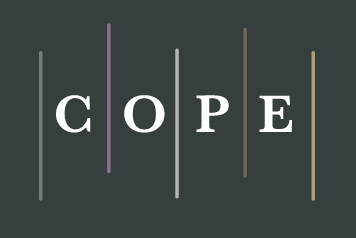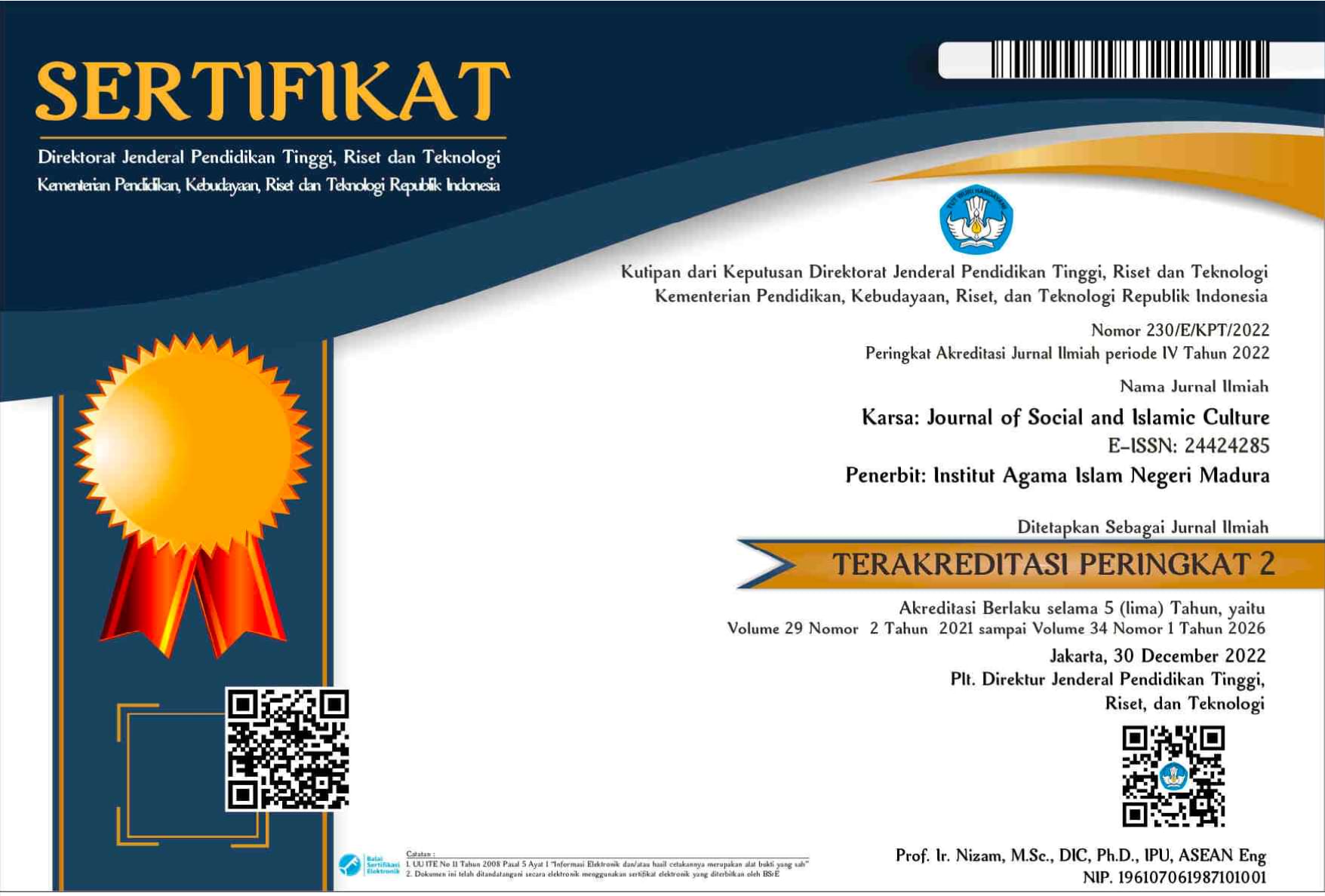Interrelation of Religion and Culture in Gunungan Tradition Cosmology: Islamic and Javanese Perspectives
 Abstract views: 540
,
Abstract views: 540
,
 PDF downloads: 382
PDF downloads: 382
Abstract
Philosophically, the science of The Qur’an about mountains is interpreted as a system of local awareness in the form of spiritual communication in the gunungan tradition of Javanese society. The concept of mountains in the Qur’an is scientific proof (kauniyah) of the Oneness of God as the Javanese interpret it as the concept of Gusti Manunggal. This dialectical relationship can be traced through the meaning of mountain cosmology in the Qur’an and Javanese philosophy in the perspective of interrelation between religion and culture. This study aims to explain mountains in the scientific perspective of the Qur’an with various functions which philosophically have a strong relationship in the gunungan tradition of the Garabek, Tumpeng, Slametan, and Sekaten rituals as the embodiment of tauhid in Central Java or Panjang-jimat in West Java. The method used is a thematic interpretation study with a descriptive narrative approach. Research on mountain cosmology or gunungan in the perspective of Islam and Javanese culture finds that (1) Gunungan is a form of symbolic communication that functions as an adhesive for the ordinary people on the one hand and at the same time spiritual. (2) The mountain is a universal system that affects the life of the Javanese people in fulfilling their life needs in an ecosystem function. (3) The gunungan tradition is a medium for praying, gratitude as a form of application, safety, and peace, as well as a medium for the spread of Islam. It can be concluded that the relationship between Islam and Javanese culture is a unified and unique Islamic characteristic in expressing theological and ecological awareness.
Downloads
References
Adib, Ahmad, and Kundharu Saddhono. “Paradigma Budaya Islam-Jawa Dalam Gerebeg Maulid Kraton Surakarta.” Al Qalam 35, no. 2 (2018): 271–96. https://doi.org/10.32678/alqalam.v35i2.1081.
Agama, Kementerian. Gunung Dalam Perspektif Al Qur’an dan Sains,. Jakarta, 2016.
Ahmad, Yusuf Haji. Mausuatul I’jaz Al ’Ilmi. 2nd ed. Damaskus: Maktabah Ibnu Hajar, 2003.
Al-Jamal, Hasan ‘Izzuddin bin ‘Abdul Fattah Ahmad. Makhthutah Al-Jamal: Mu’jam Wa Tafsir Lughawy Li Kalimat Al-Qur’an. Kairo: Al- Haiah al-Mashriyah al-’Amah li al-Kutub, 2003.
Al-Najjar, Zaglul. “Madkhal Ila Dirasah Al-I’jaz Al-"ilm Fi Al-Quran Al-Karim Wa Al-Sunnah Al-Nabawiyah Al-Mutahharah.” lebanon: Dar Ma’rifah, 2009. www.marefah.com.
Angelina, Patricia Jessy, and Laksmi K Wardani. “Makna Ruang Ritual Dan Upacara Pada Interior Keraton Surakarta.” Jurnal Intra 2, no. 2 (2014): 294–301. http://publication.petra.ac.id/index.php/ desain-interior/article/viewFile/2096/1888.
Arifin, Samsul. Gunung Dalam Al Qur’an. Yogyakarta: Universitas Islam Negeri Sunan Kalijaga, 2015.
Aswoyo, Joko, and Sularso Sularso. “The Concept of Panutan in Governance Festival Lima Gunung in Magelang Central Java Indonesia.” Harmonia: Journal of Arts Research and Education 20, no. 1 (2020): 1–9. https://doi.org/10.15294/harmonia.v20i1. 24818.
Azra, Azyumardi. “Islamisasi Jawa.” Studia Islamika 20, no. 1 (2013): 169–77. https://doi.org/10.15408/sdi.v20i1.352.
Baqi’, Muhamma Abdul. Mu’jam Al Mufahras Li Al Fadzi Al Qur’an. Mesir: Dar al Kutub, 1945.
Boogert, Jochem van den. “The Role of Slametan in the Discourse on Javanese Islam.” Indonesia and the Malay World 45, no. 133 (2017): 352–72. https://doi.org/10.1080/13639811.2017.1345 166.
Chodhuri, Abdul Alim Abdurrahman. Al Thabiyyatu Wal I’jaz Al ’Ilmi Lil Qur’an Al Karim. Palestina: Dar al Su’udiyyah, 1986.
Fakhri, Jamal. “Sains dan Teknologi dalam Al-Qur’an Dan Implikasinya dalam Pembelajaran.” Ta’dib 15, no. 01 (2010): 121–42. https://e-journal.iaingorontalo.ac.id/index.php/almuzak ki/article/view/107.
Guessoum, Nidhal. Islam’s Quantum Question; Reconciling Muslim Tradition and Modern Science. London: New York: I.B.Tauris, 2011.
Harfa, Ahmad. “Keseimbangan Penciptaan Bumi Menurut Al Qur’an Dan Sains.” UIN Syarif Hidayatullah, 2011.
Hermawan, Maulana. “Philosophical Gunungan in Puppet: A Semiotic Study.” SSRN Electronic Journal 2 (2018). https://doi.org/10. 2139/ssrn.3315129.
Houben, Vincent. “Islam and the Perception of Islam in Contemporary Indonesia.” Heidelberg Ethnology 3 (2015). https://doi.org/10. 11588/hdethn.0.0.25362.
Imron, Fuad Taufiq. “Konsep Gunung Dalam Kitab Al-Jawahir Fi Tafsir Al-Qur’an Al-Karim (Perspektif Sains Moderen).” Universitas Islam Negeri Walisongo, Semarang, 2016.
Iqbal, Muzaffar. Science and Islam. London: Greenwood Press, 2007.
Isuzu, Toshihiko. Ethical Religious Concepts in the Qur'an. Canada: McGill Queen University Press, 2002.
Isuzu, Toshihiko. God and Man in the Qur’an; Semantics of the Qur’anic Weltanschauung. Tokyo: Islamic book Trust, 2008.
Jasmi, Kamarul Azmi, and Nurliyana Ahmad Zawawi. Al-Qur’an Dan Geografi. 1st ed. Johor Bahru: UTM Press, 2013.
Kersten, Carool. “Islamisation and Its Opponents in Java: A Political, Social, Cultural and Religious History, c. 1930 to the Present by M. C. Ricklefs.” Ilahiyat Studies 6, no. 2 (2015): 263–67. https://doi.org/10.12730/13091719.2015.62.135.
Khudri, Abdul ‘Alim Abdurrahman. Al Tabi’iyyat Wa Al I’jaz Al ‘Ilmi Lil Qur’an Al Karim. Bagdad: Dar al Su’udiyah, 1987.
Kuncoro, Yohanes Arie. “Komunikasi Ritual Garebeg Di Keraton Yogyakarta.” Jurnal ASPIKOM 3, no. 4 (2018): 623–34. https:// doi.org/10.24329/aspikom.v3i4.189.
Malvini, Agustina Dwisati. World Heritage Nature and Culture. Jakarta: Batara Publishing, 2009.
Muhaimin, Abdul Ghaffar. The Islamic Traditions of Cirebon: Ibadat and Adat Among Javanese Muslims. Australia: ANU e-Press, 2006. https://doi.org/10.26530/oapen_459298.
Muqoddam, Faqihul; Maghfiroh, Virgin Suciyanti. “Syncretism of Slametan Tradition As a Pillar of Islam Nusantara.” Karsa: Journal of Social and Islamic Culture 27, no. 1 (2019): 75–93. https://doi.org/10.19105/karsa.v27i1.1950.
Muqoyyidin, Andik Wahyun. “Dialektika Islam Dan Budaya Lokal Dalam Bidang Sosial Sebagai Salah Satu Wajah Islam Jawa.” El-Harakah 14, no. 1 (2012): 18–33. https://doi.org/10.18860/el. v0i0.2197.
Naggar, Z.R. El. The Geological Concept of Mountain In The Qur'an. Cairo: Al Falah Foundation, 2003.
Nasir, Mohamad Abdun. “Revisiting the Javanese Muslim Slametan: Islam, Local Tradition, Honor and Symbolic Communication.” Al-Jami’ah 57, no. 2 (2019):329-358. https://doi.org/10.14421/ajis. 2019.572.329-358.
Nasr, Sayyed Hosein. Ideals and Realities of Islam. London: George Allen and Unwin, 1972.
Nasr, Sayyed Hossein. Science and Civilization in Islam. Chicago: ABC International Group, 2001.
Ras, J. J. Javanese Literature since Independence: An Anthology. London: New York: Brill, 1979.
Rosyidi, Abdul Wahab. “Doa DaLam Tradisi Islam Jawa.” El-Harakah 14, no. 1 (2012): 88–100. https://doi.org/10.18860/el.v0i0.2199.
Rubaidi, Rubaidi. “Javanese Islam: A Blend of Javanese Culture and Islamic Mysticism Viewed from Post-Colonial Perspective.” El Harakah: Jurnal Budaya Islam 21, no. 1 (2019): 19–36. http:// 103.17.76.13/index.php/infopub/article/view/6066.
Sardar, Ziauddin. How Do You Know?: Reading Ziauddin Sardar on Islam, Science and Cultural Relations. Science. London: Pluto Press, 2006. https://doi.org/10.1037/001156.
Setiawati, Debi. “Slametan Dalam Spiritualitas Orang Jawa Pada Masa Lalu Sampai Sekarang.” Jurnal Pendidikan Sejarah Dan Sosiologi 1, no. 1 (2019): 76–88. https://doi.org/10.33503/ maharsi.v1i01.357.
Shihab, M. Quraish. Tafsir Al Misbah. 15th ed. Jakarta: Lentera Hati, 2002.
Subiyantoro, Slamet, and Hasan Zainnuri. “Gunungan Wayang Sadat: The Study of Its Religious Values and Its Relevance in Fine Art Learning in High Schools.” Journal of Social Sciences & Humanities 25 (2017): 273–80. http://www.pertanika.upm. edu.my/.
Sugono, Dendy, Sugiyono, Yeyen Maryani, and Meity Taqdir Qodratillah. Kamus Bahasa Indonesia. Jakarta: Pusat Bahasa Departeman pendidikan Nasional, 2008.
Sulaksono, Djoko. “Filosofi Pertunjukkan Wayang Purwa.” IBDA` : Jurnal Kajian Islam Dan Budaya 11, no. 2 (January 1, 1970): 238–46. https://doi.org/10.24090/ibda.v11i2.82.
Sumbulah, Umi. “Islam Jawa Dan Akulturasi Budaya; Karakteristik, Variasi Dan Ketaatan Ekspresif.” El Harakah 14, no. 1 (2012): 51–68. https://doi.org/10.18860/el.v0i0.2191.
Sutiyono. “Tumpeng Dan Gunungan: Makna Simboliknya Dalam Kebudayaan Masyarakat Jawa.” Cakrawala Pendidikan 1, no. 1 (1998): 61–67. https://journal.uny.ac.id/index.php/cp/article/view /9041.
Suwito, Suwito, Arif Hidayat, and Sriyanto Agus. “Tradisi Dan Ritual Kematian Wong Islam Jawa.” IBDA` : Jurnal Kajian Islam Dan Budaya 13, no. 2 (1970): 6–25. https://doi.org/10.24090/ibda. v13i2.659.
Turner, Howard R. Science in Medieval Islam: An Illustrated Introduction. 2006: University of Texas Press, 1998. https://doi. org/10.5860/choice.35-5041.
Usaimin, Muhammad bin Sholeh. Fath Zuljalali Wa Al Ikram Bi Syarh Buughul Maram. Mesir: Maktabah Islamiyah, 2006.
Yahaya, Mahayudin Haji. “Alam Semesta Dan Bencana Alam Dari Perspektif Agama Dan Sains.” Unimap 1 (2012): 71–85. http://dspace.unimap.edu.my:80/xmlui/handle/123456789/41419.
Yunarma, Andreas. “Konsep Manusia Dalam Gunungan Sebuah Refleksi Filosofis Terhadap Kearifan Lokal.” Jurnal Filsafat 22, no. 1 (2012): 18–30. https://doi.org/10.22146/jf.12983.
Zaini, Muhammad Sibam Rusydi. Mu’jam Al Mufahras Li Ma’anil Qur’an. first ed. Beirut-Lebanon: Dar al Fikri, 1995.
The journal operates an Open Access policy under a Creative Commons Non-Commercial Share-Alike license. Authors who publish with this journal agree to the following terms:
- Authors retain copyright and grant the journal right of first publication with the work simultaneously licensed under a Creative Commons Attribution License that allows others to share the work with an acknowledgement of the work's authorship and initial publication in this journal.
- Authors are able to enter into separate, additional contractual arrangements for the non-exclusive distribution of the journal's published version of the work (e.g., post it to an institutional repository or publish it in a book), with an acknowledgement of its initial publication in this journal.
- Authors are permitted and encouraged to post their work online (e.g., in institutional repositories or on their website) prior to and during the submission process, as it can lead to productive exchanges, as well as earlier and greater citation of published work.





















